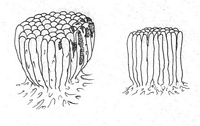|
 Tubifera ferruginosa Tubifera ferruginosa
SynonymsTubulina fragiformis
Stemonitis ferruginosa
Tubulifera arachnoidea
BiostatusPresent in region - Indigenous. Non endemic
Images (click to enlarge)
Caption: Two aethalia of Tubifera ferruginosa. The one on the left is approximately 0.5 cm tall.
Owner: S.L. Stephenson |
Article: Stephenson, S.L. (2003). Myxomycetes of New Zealand. Fungi of New Zealand. Ngā Harore o Aotearoa 3: xiv + 238 p. Hong Kong: Fungal Diversity Press.
Description: Fruiting body a pseudoaethalium composed of numerous sessile sporangia crowded together, individual sporangia cylindrical to ovate, pale umber to reddish brown or purplish brown, up to 0.4 mm in diameter and 5 mm tall, the entire structure reaching 15 cm or more in extent. Hypothallus well developed, membranous to spongy, colourless or pallid. Peridium membranous, thin, persisting in mature fruiting bodies except at the apices of the individual sporangia, where it tends to break away. Spores umber-brown in mass, pallid by transmitted light, finely reticulate over about three-quarters of the surface, 6–8 µm in diameter. Plasmodium watery and colourless upon emergence, becoming milky white, and then changing through rose to brown in fruiting.
Habitat: Decaying wood or wood debris; occasionally occurring on forest floor leaf litter.
Distribution: Cosmopolitan and reported from areas of the world ranging from high-latitude boreal forest/tundra to the tropics. First reported (as Tubulina fragiformis) from New Zealand by Lister & Lister (1905), based on a specimen collected in Taranaki. Also known from Auckland, Bay of Plenty, Wanganui, Gisborne, Marlborough Sounds, Southland (Rawson 1937), and Stewart Island.
Notes: Because of its relatively large size and distinctive structure, this species is not likely to be confused with any other myxomycete. Like Reticularia lycoperdon, mature fruiting bodies of Tubifera ferruginosa are sometimes invaded by small beetles that feed upon the spore mass. Lado (2001) pointed out that the generic name
|